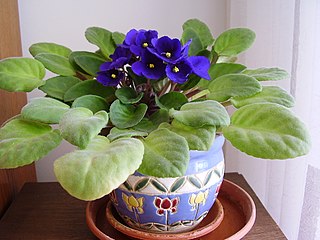
In the botanical classification of plants, Aeridinae Pfitzer is a subtribe of the tribe Vandeae whose representatives all have a monopodial growth habit and do not possess pseudobulbs.

Gesneriaceae, the gesneriad family, is a family of flowering plants consisting of about 152 genera and ca. 3,540 species in the tropics and subtropics of the Old World and the New World, with a very small number extending to temperate areas. Many species have colorful and showy flowers and are cultivated as ornamental plants.

Rhipsalidopsis is a small genus of flowering plant in the family Cactaceae, native to southern Brazil. Like other members of the tribe Rhipsalideae, its species are epiphytes, growing on trees.

Dicranopteris (forkedfern) is a genus of tropical ferns of the family Gleicheniaceae. There are about 20 described species.

Oxossia is a genus of flowering plants in the subfamily Turneroideae (Passifloraceae) consisting of 15 species. This genus was recently defined in 2019 after a phylogenetic analysis of Turnera justified the creation of the genus. The genus is characterized by its stipules, small flowers, congested inflorescences, "hairy" stamen and style, and the attachment of stamen to the floral tube. All members of the genus are heterostylous with the exception of O. dasystyla. The genus can be divided into two morphological groups: those with white petals and those with yellow pink or red petals.
Oxossia albicans is a subshrub in the genus Oxossia. It is native to the wet tropics of eastern Brazil, specifically the Atlantic forest. It is 40 - 80 cm tall and has yellow heterostylous flowers.
Oxossia annularis is a shrub of Oxossia Turneroideae (Passifloraceae) native to eastern Brazil. It is found in Caatinga, Cerrado, and Atlantic Forest. O. annularis has 2–10 mm long petioles, rigid elliptical, ovate, or obovate leaves with serrated margins and heterostylous flowers.

Oxossia calyptrocarpa, a member of Turneroideae (Passifloraceae), is a shrub native to the wet tropics of eastern Brazil. It is found in the Caatinga, Cerrado, and Atlantic forest. It is 0.2-2.5 meter tall with highly plasticitic leaves and white to lilac flowers. It is a heterostylous species.
Oxossia capitata is a shrub native to the wet tropics of southern Brazil. It was previously classified as Turnera, however, recent phylogenetic analyses suggested the species should be placed in Oxossia.O. capitata has heterostylous white pointed flowers.
Callerya bonatiana is a species of flowering plant in the family Fabaceae, native to south-central and southeastern mainland China, Laos and Vietnam. It was first described in 1910 as Millettia bonatiana.
Oxossia dasystyla is a shrub native to southeast Brazil. It is native to the jungles and surrounding fields of Minas Gerais; specifically the Caatinga and Atlantic Forest.
Oxossia hatschbachii is a species of shrub in the genus Oxossia (Passifloraceae). It is native to the Atlantic Rainforest near Espírito Santo, Brazil. O. hatchbachii has heterostylous racemose flowers, ranging in color from white to red.
Oxossia hebepetala is shrub in the genus Oxossia (Passifloraceae). It is native to the Caatinga of Bahria and Piauí, Brazil.
Oxossia maracasana is a shrub in the genus Oxossia (Passifloraceae). It is native the Caatinga regions and Atlantic forest near Bahia, Brazil. It has white heterostylous flowers.
Oxossia marmorata is a shrub in the genus Oxossia (Passifloraceae). It is native to the Atlantic Rainforest of Brazil. It can be distinguished from other members of the genus by its yellow flowers. Similar to other members of Oxossia, O. marmorata has distylous flowers.
Oxossia pernambucensis is a shrub in the genus Oxossia (Passifloraceae). It is native to the Atlantic Rainforest of Brazil. The species is currently represented by a single population and thus is currently classified as critically endangered.
Oxossia princeps is a subshrub in the genus Oxossia (Passifloraceae). It is native to the savanna of Minas Gerais, Brazil. It is considered "rare", but its conservation classification is currently unknown.
Oxossia rubrobracteata is a shrub in the genus Oxossia (Passifloraceae). It is native to the Atlantic Rainforest of Brazil.
Oxossia spicata is a shrub in the genus Oxossia (Passifloraceae). It is native to the Atlantic Rainforest of Espírito Santo, Brazil. The species is known from three different populations, however, additional field work is needed to determine the conservation status of O. spicata.
Oxossia waltherioides is a subshrub in the genus Oxossia (Passifloraceae). It is native to the Amazon Rainforest of Roraima, Brazil.





